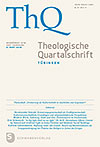archivierte
Ausgabe 3/2023 |


 |
      |
 |
|
|
|
|
 |
|
| Leseprobe 3 |
DOI: 10.14623/thq.2023.3.292–322 |
|
| Eva Spinazzè |
| “In thy light shall we see light” (Ps 36:9) |
| Hierophanic Effects Created by Natural and Artificial Light in Early Christian and Medieval Sacred Buildings |
 |
Zusammenfassung
Diese Studie vergleicht natürliches Licht und künstliches Licht in Sakralbauten des frühen Christentums und des Mittelalters. Sie untersucht anhand schriftlicher Primärquellen die Symbolik des Lichts in der Antike. Die Fragen lauten: Welche Funktion hatte das Licht im Inneren der heiligen Stätte? Ist es heute möglich, die Wirkung von natürlichem und künstlichem Licht in antiken Kirchen zu rekonstruieren? Die Arbeit konzentriert sich vor allem auf das Verständnis des künstlichen Lichts in antiken Sakralbauten und auf die Bewertung ihrer Wirkungen bei religiösen Nachtprozessionen und liturgischen Festen. Die Autorin versucht, Ordnung in die verschiedenen Aspekte zu bringen, die in verschiedenen Workshops zur Rekonstruktion des künstlichen Lichts in mittelalterlichen Sakralbauten vorgebracht wurden.
Abstract
This study compares natural light and artificial light inside sacred buildings from the Early Christian and Middle Ages. It examines through primary written sources the symbology of light in antiquity. The questions are: What function had light inside the holy place? Is it possible today to reconstruct the effects of natural and artificial light in ancient churches? The paper focuses mainly on the understanding of artificial light used in ancient sacred buildings and on the evaluation of the effects of artificial illumination during religious night processions and liturgical feasts. The author tries to bring some order to the different arguments put forward during various workshops dedicated to the reconstruction of artificial light in medieval sacred buildings.
Schlüsselwörter/Keywords
Kirchen; künstliches Licht; natürliches Licht; Liturgie; Lichtsymbolik; frühes Christentum; Mittelalter; Abt Suger; Augustinus von Hippo; Bonaventura von Bagnoregio; Dionysius Cartusianus; Egeria; Eusebius Pamphilus; Evagrius Scholasticus; Gregorius Nazianzenus; Laurentius von Brindisi; Paulinus von Nola; Procopius Caesariensis; Symeon Thessalonicensis; Thomae von Kempen; Thomas von Aquin
Churches; artificial light; natural light; liturgy; symbology of light; Early Christianity; Middle Ages; Abbot Suger; Augustinus Hipponensis; Bonaventura da Bagnoregio; Dionysius Cartusianus; Egeria; Eusebius Pamphilus; Evagrius Scholasticus; Gregorius Nazianzenus; Laurentius a Brundusio; Paulinus of Nola; Procopius Caesariensis; Symeon Thessalonicensis; Thomae Hemerken à Kempis; Thomas Aquinas
1. Introduction
The evidence of natural light effects within sacred spaces is abundant and can still be found to this day in many churches of medieval origin. Examples exist where natural light emphasizes a symbolic meaning by manifesting every year on a significant day in a specific part of the church. The builder’s intention was probably to highlight a religious thought and convey a message through light. In this way, light became the herald of that message. These hierophanic messages can be seen mainly in the alignment to the rising or setting of the Sun or the Moon, in the illuminating of the main architectural elements inside the church, or in enlightening the frescoes or mosaics.
Studies on the orientation of early Christian or medieval sacred buildings show that the builder sometimes intended to use light to underline a Christian rite or celebration such as the solemn feasts of Easter and Christmas, or one of the Marian feasts celebrated throughout the Middle Ages (the Purification, the Annunciation, the Assumption or the Nativity of Mary), the anniversary of the saint to whom the church was dedicated, the translation of the patron saint’s remains, whose relics were often kept under the altar or in a crypt. It can be noted that the four astronomical dates that mark the seasonal change have been associated with four solemn liturgical feasts: the winter solstice falls close to Christmas (25th December), the summer solstice with the Nativity of Saint John the Baptist (24th June), the spring equinox with the Annunciation to Mary (25th March), and the autumn equinox with Michaelmas (29th September). These dates are often reflected in the axis alignments of medieval churches together with the other three main Marian feasts celebrated during the Middle Ages (Assumption, 15th August; Nativity, 8th September; Purification, 2nd February).
Nowadays, reconstructing the day based on which the church alignment was designed and discovering the message conveyed by the light is possible in numerous cases. Through georeferenced surveys coupled with astronomical and trigonometric calculations, information on the azimuth of the axis of the church and declination can be obtained. Based on these data, the days in which a celestial body was aligned with the axis of the sacred building can be deduced. In order to be able to interpret the dates correctly, knowledge of the history of the sacred building under consideration is fundamental. We do not conceptualize the Sun as ancient cultures did. Their understanding has been lost. To comprehend the great works of past cultures, one must know and consider their spiritual thoughts.
On the contrary, reconstructing the real effects created by artificial lights (through the use of candles and oil lamps) in a medieval sacred building and its lighting mode is no longer possible. In reconstructing the effects of artificial light, too many variables would have to be considered, most of them being impossible to replicate, and therefore this would lead to uncertain, implausible results. These reconstructions remain in the domain of speculation, unless documents are found that indicate the type of lighting devices (candles, oil lamps, portable, hanging or standing lamps, candelabra – every device provides for a different form of illumination), the material (silver, gold, bronze, clear glass), their position inside the sacred space, the number of devices, the fuel used, the size of the devices, the time of lighting (at dawn, during the day, at vesper, during the night), how many devices were lit at the same time and on which liturgical feast days they were used (the time of year). However, written sources do not normally provide information on how many light sources were lit at the same time and where they were placed. Today, most of these liturgical objects have been lost, while other devices may be found in local museums, separated from its original setting, removed from sacred buildings, is seen only as an artifact, thus being impossible to retrace the light effects created during the rite and the liturgical feasts. Different types and numbers of lamps were lit in relation to the various celebrations. [...]
Lesen Sie den kompletten Artikel in der Printausgabe.
|
|
|
|
|
|
|
Anzeigen
|
Mit Anzeigen und Inseraten erreichen Sie Ihre Zielgruppe. Anzeige aufgeben
|
 |
|
Unsere Dienstleistung für Verlage, die Ihr Abogeschäft in gute Hände geben wollen.
|

mehr
Informationen
|
 |
|
| Bücher & mehr |

|
|

